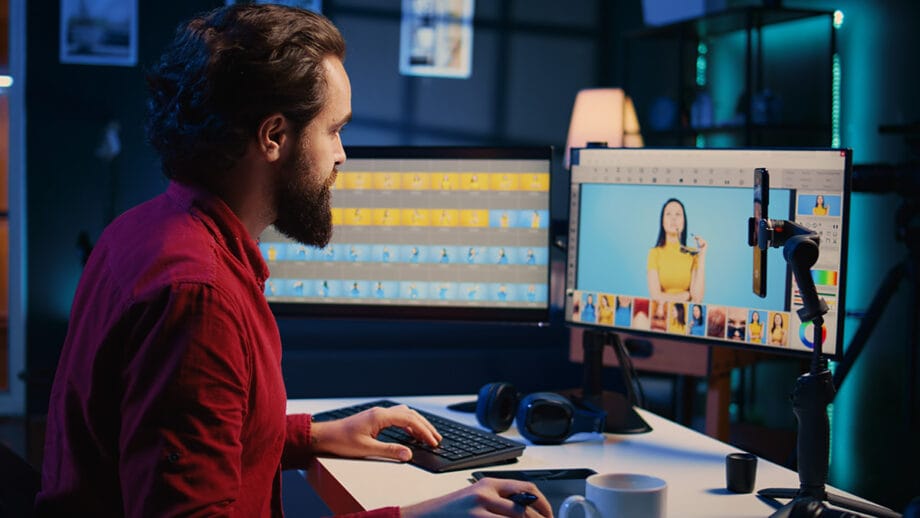Video creation used to be a time-consuming process, requiring expensive equipment, technical skills, and hours of editing. But in 2025, AI video generators are revolutionizing the process. With a few clicks, anyone can now produce high-quality, engaging videos from text, images, or prompts – no experience required.
This beginner-friendly guide will walk you through AI video creation basics, the process of AI video generation, creating your first-ever video, and the best tools to get you started.
What is an AI Video Generator?


An AI video generator is an artificial intelligence-powered software tool that automatically creates videos based on user inputs. Instead of editing manually, you provide content like:
A written prompt or script.One or more images.Video clips or voiceovers.
The AI thereafter generates a video with transitions, animations, sound effects, music, and even captions. It can duplicate anything ranging from a corporate explainer video to a TikTok-style reel, according to your needs and the platform you choose.
AI video creators utilize a mix of machine learning algorithms, computer vision, and natural language processing to understand the content you provide them with and structure a video that presents your idea visually.
Why are AI Video Tools So Popular?
In the age of instant content consumption, people need tools to produce great videos quickly. Here’s why AI video creators have become so popular:
They Save Time: Instead of spending hours editing raw footage, these tools produce videos in minutes. You can produce more content more quickly, ideal for social media marketers, educators, and startups.They’re Cost-Effective: Professional editing software or agencies charge hundreds or thousands of dollars. Most AI video generators offer free plans or low-cost monthly subscriptions.They’re User-Friendly: You don’t need to learn any video editing software like Adobe Premiere or Final Cut Pro. It’s all drag-and-drop or prompt-based. Even if you’re a complete beginner at video making, AI video tools allow you to achieve stunning results.They’re Versatile: Whether product promos and YouTube intros, educational explainers, or personal slideshows, AI video generators can do them all.
Best AI Video Generators for Beginners


There are dozens of AI video tools, but these five are perfect for getting started:
1. Deevid AI
Deevid AI enables users to turn static images or short prompts into cinematic video footage. It features stylized templates, including anime-style, Ghibli-like animation, and aesthetic effects. Upload a photo or describe a scene, and the tool brings it to life with motion, effects, and transitions.
Best For: Creative projects, animated reels, and stylized content.Free Plan Available: Yes, with daily credits.No Editing Skills Needed: Yes.
2. Pictory
Pictory converts long-form text, such as blog posts or webinars, into short, engaging videos. It uses AI voiceover, stock video footage, and subtitle overlays.
Best For: Marketers, educators, and bloggers.Free Plan Available: Yes.Notable Feature: Converts blogs into videos in under 10 minutes.
3. Lumen5
Lumen5 specializes in turning written content into social media videos. You paste in your script, choose visuals, and the AI assembles it all into a branded video with logo, music, and color scheme.
Best For: Content marketers and social media managers.Free Plan Available: Yes.Templates: Yes, many for different industries.
4. Synthesia
Synthesia allows you to create talking head videos with AI avatars. It’s perfect for product demos, tutorials, or internal training videos.
Best For: Business presentations and explainer videos.Free Plan Available: Demo version.Languages Supported: Over 120.
5. Runway ML
Runway ML offers video editing powered by AI, including text-to-video generation, inpainting on videos, and background removal. It’s a better option if you want creative control after generation.
Best For: Digital artists, editors, and video creators.Free Plan Available: Yes, with a watermark.Skill Level: Slightly more advanced.
How to Make Your First AI Video: Step-by-Step


Let’s say you are using Deevid AI or Lumen5. The following is a simplified step-by-step process of creating your very first AI-generated video.
Step 1: Decide the Purpose of Your Video
Ask yourself:
Is it for marketing, educational, or entertainment purposes?Who are your viewers?Do you want it to be formal, fun, emotional, or informative?
Having a clear purpose helps the AI generator choose related scenes, transitions, and music.
Step 2: Choose the Content Format
You’ll have to decide what you’re starting with:
A few sentences of descriptive text.A whole blog post or script.Artwork or images.A video clip or voiceover (if you want).
Text is the easiest place to start for beginners.
Step 3: Pick a Template or Style
Most software will have templates for different use cases – ads, tutorials, or trailers, for example. You can also choose a style (minimalist, cinematic, colorful, etc.) and the output size (square, vertical, or landscape).
If you’re using Deevid AI, you can choose aesthetic-based styles such as anime, vintage, or cinematic zoom.
Step 4: Customize
AI software will typically auto-generate scenes, but you can customize:
Text overlays or captions.Music or voiceover.Scene order or timing.Transitions and visual effects.
Avoid over-editing on the first try – let the AI show you what it can do.
Step 5: Render and Export
Click the “Generate” button, and the tool will create your video. This can take anywhere from 30 seconds to 5 minutes, depending on complexity and duration.
Preview your output. Edit, regenerate, or download and publish as needed.
Tips for First-Time Success


For improved results as a first-timer, keep these tips in mind:
Start Simple: Do not overcomplicate your first video. One image and a short prompt can go a long way.Keep Scripts Concise: AI narration and subtitle engines are served better by punchy, short sentences.Use Quality Inputs: Upload high-quality images or twice-proofread grammar in scripts for the best results.Test Different Templates: Try two or three styles for the same input and compare results. Most tools let you re-generate with a single click.Preview Before Posting: Preview your video always before posting to spot stilted transitions, off-topic visuals, or mistimed captions.
Use Cases: Where You Can Use AI Videos
AI videos are being used in more places than ever. Some ideas are:
Marketing: Create product explainers, testimonial videos, or ad reels.Education: Turn lessons or slideshows into video tutorials with voiceovers.Content Creation: Turn blog posts or tweets into mini videos.E-commerce: Turn product photos into video ads with animations.Artistic Projects: Turn paintings, sketches, or photos into cinematic reels.


Emerging Trends in AI Video Creation
AI video creation is moving very fast, and features are being added that are changing the nature of how content is being created, shared, and consumed.
The biggest trend is AI lip-syncing and avatar creation. The tools can now create characters that can lip-sync along with your script, with multiple languages and accents supported. This makes it possible to produce training videos, explainer videos, and even entertainment clips that appear to be highly personalized and human-like, without hiring actors or voiceover artists.
Another new trend is including next-gen style transfer functionality. For example, Deevid AI enables creators to create animated content in Ghibli or dreamcore aesthetics, overlaying a visually striking look to bland prompts. That is especially useful for influencers and brands that want a unique visual identity. As more platforms support this type of neural rendering, creators will be able to input raw text or static pictures and have them transformed automatically into polished, stylized narratives.
Besides visuals, AI-created background music and soundscapes are also being included. Websites like Pictory and InVideo now allow users to sync tempo and mood with machine learning-driven soundtrack selection. These small features totally boost the video quality, enabling creators to evoke emotion and induce audience engagement without having to raise a finger in audio editing apps.
Learning and Creator Communities
While these tools are powerful, they may be overwhelming for beginners. Thankfully, many of the leading AI video creators have built robust learning environments to help users level up quickly. Lumen5, for example, features an intuitive interface and a good onboarding tutorial library, so you can start turning blogs into branded videos in minutes. Pictory also has assistance, especially when it comes to repurposing video content such as long-form webinars and Zoom calls.


Some of these platforms take it a step further by building active communities of creators and learning hubs. InVideo, for instance, has an in-app Creator’s Academy where users can learn video courses, workshops, and even contest-taking opportunities. These kinds of communities are very useful to seek inspiration, resolve technical issues, or share tips on best practices with fellow travelers on the same creative journey.
Above all, such resources help users to break away from the bare minimum template use and to a video storyteller mentality. They teach skills around pacing, call-to-actions, and brand alignment – capabilities that can transform an AI-generated clip from good to great. As AI capabilities become more advanced, human creativity – and that will be the differentiating factor – can be helped by learning environments to close the gap.
Mobile Compatibility and On-the-Go Creation
But another revolutionary feature of current AI video software is its availability on mobile phones. More and more platforms are launching mobile apps or web editors with adaptive designs that allow users to produce, edit, and share videos directly from their phones.
This is particularly disruptive for remote content creators who are often traveling, always on the road, or have a focus on live event coverage. With two taps, they can upload pictures or type out a short script and get a social-ready video in minutes.
For example, Animoto’s mobile experience allows you to drag and drop photos, apply filters, and even preview video sequences in real time. InVideo’s app features voiceovers and allows you to edit clips, adjust timing, and schedule posts even on social media websites like Instagram and YouTube. The combination of AI efficiency and mobile accessibility gives creators genuine on-the-move production power.
This mobile-first phenomenon also enables more impromptu content creation. Instead of planning, filming, and editing on numerous devices, creators can now film finished videos while walking to work, during breaks, or in between meetings. As the entry point lowers, creativity becomes more about timing and narrative and less about gear or post-production skills.
Final Thoughts


AI video makers are changing the face of storytelling and communication. No longer do you need to be a video editor, animator, or motion designer to produce compelling video content. With easy-to-use interfaces and automated editing, you can go from concept to publish-ready video in minutes.
If you’ve never created a video before, now is the time to try. Tools like Deevid AI, Lumen5, and Pictory make video creation fast, easy, and even fun.
Your first AI video is just a few clicks away – so dive in, experiment, and let the technology do the heavy lifting.

